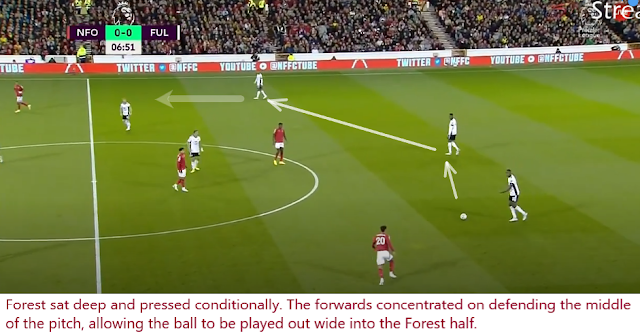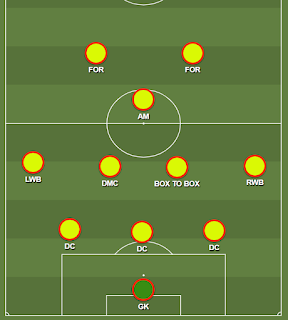Forest 2 Fulham 3 - Tactical analysis
Forest’s tough adjustment to The Premier League continued last week with a disappointing 3-2 defeat at home to Fulham.
Steve Cooper persevered with the 3-4-1-2 system that earned promotion. He made interesting changes in personnel which altered the way The Reds would play the game; Taiwo Awoniyi was brought in to add strength up front, and Willy Boly was preferred to club captain Joe Worrall in defence.Fulham lined up in a 4-2-3-1, spearheaded by the dangerous Alexander Mitrovic. They have been willing to sit off and hit on the counter-attack so far this season, seeing much less of the ball than they became used to in The Championship, however this was to change at The City Ground.
Forest’s main problem this season has been the unfamiliarity within the squad. Cooper has a lot of new players to work with – good players, but they have been struggling for cohesion, particularly when out of possession. This prompted a change of strategy.
A classic sign of players not knowing the system adequately is them being dragged out of position with their team-mates unable to cover, causing the team to lose shape. This has been a huge problem in previous games – Cooper appears to have reacted by simplifying their roles defensively.
We see this typically when a new manager comes into a club – they tighten at the back, concentrate on protecting the most vulnerable areas and expand forward from there. A good example at Forest is when Dougie Freedman arrived and improved results – he simply told his players to defend the middle of their half of the pitch and sit deep.
I think this is what Cooper initially did against Fulham; Forest defended deep in a back five and concentrated on stopping Fulham play through the middle of midfield. With less ground to cover, in theory, there would be less players being dragged out of position – and less space closer to the Forest goal.
Off the ball the forwards were told to stay narrow, which allowed Fulham to play around them and have relatively easy access to the Forest half. This has caused some fans to point fingers at the lack of pressing – Brennan Johnson (naturally as the academy product) being singled out despite the instruction applying to all three players.
Cooper was probably happy for Fulham to have the ball in these areas, for them to creep forward, in the expectation that Forest could get in behind and hit them on the break. The inclusion of Awoniyi made this more of a threat. Whenever the front three became involved they looked dangerous.However Forest struggled to keep the ball and progress up the pitch, as without Worrall they were less able to build play from the back.
We saw the first sign of this after just a minute, with his replacement, Boly, forgetting how Forest play and launching the ball up front.
The Ivorian settled into the system. He participated well in the way Forest’s back three split to receive the ball, and tried to pass through the middle, however the role did not suit him in possession. To compensate Neco Williams dropped further back for the ball more often than is normal, and other players were making strange runs out of position.An interesting point was that in allowing Fulham to advance into the wide areas with their full-backs (usually Kenny Tete), Forest were allowing them to utilise their spare man, leading to an apparent tactical advantage.
Strategically, different formations naturally leave teams with spare men in different areas. Forest’s 3-4-1-2 when up against a 4-2-3-1 has a spare man in central defence, while the 4-2-3-1’s spare man is either one of the full-backs depending on where the ball is.
Initially, Forest used their spare man better against Bournemouth last week; Joe Worrall was damaging them by helping to progress the ball through midfield, while Bournemouth’s full-backs were being pinned back, or exploited when they tried to get forward and influence play. This forced Bournemouth to change shape.
However with Forest’s wing-backs set further back, and the forwards pressing narrowly, Fulham could advance their full-backs into the empty spaces out wide, leading to a lot of possession in Forest’s half of the pitch, and pressure.
With Forest sitting back, and less able/willing to play through the middle, Fulham therefore enjoyed 59.2% of possession (which is high for them – up until this game their average was 38.7%). This was due to them being able to use their spare man better than Forest could theirs. The flow of the game settled into Fulham pressure punctuated by Forest counter attacks.
Forest’s fast attacking paid off first. Probably the first time they were able to play through the middle they scored, with Ryan Yates playing a perfect reverse ball to release Brennan Johnson – Forest scored from the resulting corner.However Fulham did not panic and continued the squeeze, scoring from a corner of their own after the break.
Panic.
Panic was the difference between the two teams – the Fulham players all knew their jobs and trusted their teammates. Upon going behind they were disciplined.
Forest’s concession was followed by 5 minutes and 17 seconds of chaos. Like gamblers chasing a loss, players were overstretching, trying to do too much – not trusting each other or the system. Shape was lost and Fulham were able to play through the gaps.
The second goal came from a ploy that Fulham had been attempting the whole game but up until this point Forest had been disciplined enough to resist. They had been trying to tempt Williams and the other wing-back, Renan Lodi, to press out into the empty space in front and exploit the gap.
Fulham had almost caught Lodi a couple of times in the first half, however just after the equaliser it was Williams with the rush of blood, charging out for an impossible press. Fulham pounced forcing a disorderly retreat from which Forest failed to reorganise in time.The third goal was worse: Boly triggered a strange press which left both himself and Williams out of position. An exasperated Ryan Yates failed to cover quickly enough and Fulham advanced into the space. The Reds still had enough defenders, however Lodi then failed to trust Scott McKenna to pick up Willian’s run, abandoning his own position and gifting Fulham the easiest of third goals.
Cooper immediately made changes; he switched to his plan B, a 4-2-3-1 system, and introduced steadier heads. Four at the back immediately brought more certainty, especially for Williams and Lodi, who had been unsure when to advance.
With Worrall now on the ball more than any other player on the pitch, Forest avoided the Fulham press better. Combined with the extra man forward, and the substitutes making themselves available they were now able to play through midfield.
Forest’s possession improved to 61.2% for this period – this was not due to Fulham sitting back because they did not. The Reds improved, pulling a goal back through Lewis O’Brien, but the earlier period of indiscipline had given them too much to do.
Cooper turned to a 4-2-3-1 a lot while perfecting his 3-4-1-2. Bringing Jesse Lingard on for Steve Cook was reminiscent of the Alex MIghten for Toby Figueiredo switch we saw regularly last season.
Until around February, plan B was more fruitful – we may see this change again, however we can expect Cooper to persevere in the long run with his favoured system.
Incorporating so many players is clearly causing problems - here Cooper had to change his strategy in this game just to help them stay in shape, but once they conceded they were nevertheless dragged out of position and duplicating jobs.
While they acclimatise the new players, while they tweak their plan A, Forest must start picking up points against teams like Fulham and Bournemouth, or they will become adrift at the bottom of The Premier League.











Excellent stuff
ReplyDeleteVery insightful analysis!
ReplyDeleteThanks for sharing
ReplyDeleteGreat read and analysis. Makes me wonder why Cooper made some of the changes he did for these two important games to bring in unfamiliar players.
ReplyDeleteWhy not keep Toffolo in at LWB for these two games and why not start Worrall & O’Brien against Fulham.